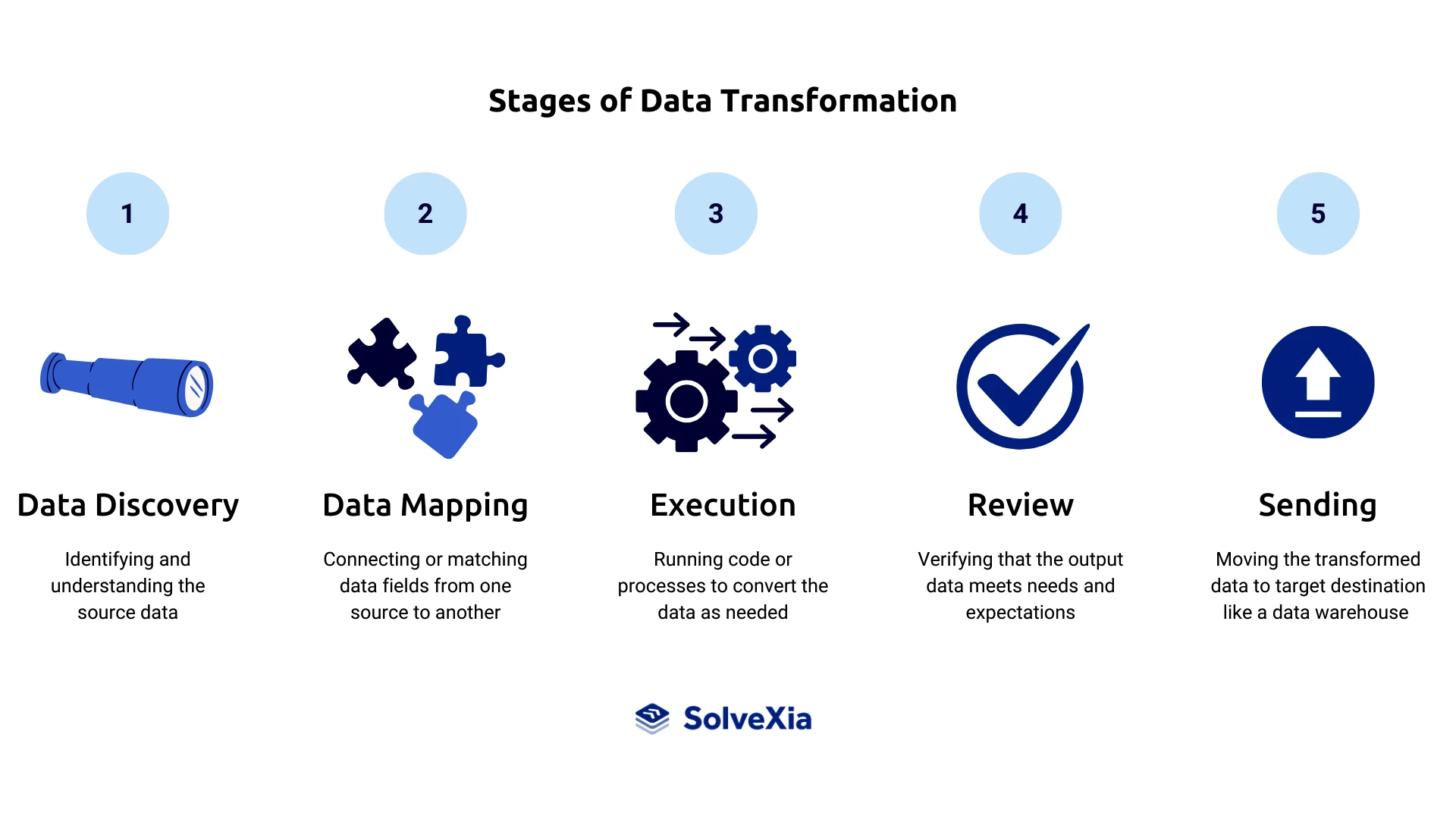Data Transformation Process: From Chaos to Clarity

A data transformation process shapes your data into a usable format to unlock valuable insights for decision-making. Whether you support data scientists and advanced data analysis or want better reporting, access to high-quality transformed data is crucial.
In this post, we will teach you important data transformation methods so that you can fuel your data analytics and business intelligence. You will also learn about the benefits of data transformation and how it will help drive your company forward.
Coming Up
Benefits of Data Transformation
The Stages of the Data Transformation Process
Data Transformation Techniques
Data Transformation Challenges
What are the Best Data Transformation Tools?
How to Get Started with Data Transformation
What is Data Transformation?
Data transformation refers to changing existing data from one format into another. This can include working with structured data and unstructured data. Typically, transforming data involves:
- Extracting raw data from data sources such as systems and files.
- Converting raw data into a format and structure suitable for downstream tasks.
- Standardizing data across purposes and use cases.
- Data cleaning an data normalization, which includes things like format conversion, identifying and removing duplicate data, and converting data to a usable format.
This can be considered a "data pipeline," structuring data for business use and measuring and improving data quality. Data transformation processes are, therefore, crucial for all organizations.
Benefits of Data Transformation
From advanced machine learning algorithms to basic report creation, your data is only valuable if it is fit for purpose. This is where data transformations are so important.
Implementing a robust process to transform data has many benefits, this includes:
Better Data Management
As organizations scale, their data growth follows suit. As new systems and multiple data sources are introduced, data transformation is often required. Defining processes for extracting and transforming data leads to better data management.
Faster Queries
When you are able to standardize and store data in a centralized location, you get the advantage of being able to quicken your query times. This means that you get the results back faster and have less friction when performing data analysis.
Improved Data Quality
Data transformation also improves data quality by removing redundancies and ensuring that data is up-to-date. Data cleaning techniques (see below) reduce the risk of misinterpretation.
Support for data integration across data sources
Having a robust data pipeline can lead to enhanced data integration. When transformed data is in a standardized format, data warehousing is easier.
The Stages of the Data Transformation Process

The data transformation process, whether manual or automatic, tends to flow through the same steps. Data transformation involves:
Discovery
It's critical to first identify data that is to be used. This happens through data discovery, or data profiling. At this step, data teams or a data automation tool will identify the raw data that will be transformed.
Mapping
Knowing how the raw data must be formatted is the only way to proceed with the process. In some cases, data analysts will have to manually list the ways the data must be filtered, modified, matched, and aggregated.
While the manual efforts required a highly-skilled and dedicated staff, an automation software can manage this aspect for you by automatically formatting the data according to the target system's needs.
Extraction
Data is moved from the source to the target system through data extraction. Extraction can either be structured (through databases) or unstructured (event streaming, log files).
Execution
After extraction and data loading in the target system, the data has to be transformed into the right format.
It will either be done by analytics engineers who have to write code or by a software solution that will do this tedious work behind-the-scenes.
Review
After the main event of the data transformation process takes place, it's a good idea to review the data to ensure it was properly implemented and stored.
Sending
Once all is in good order, it's time to close the process by moving the data into a target data warehouse or structured database.
Data Transformation Techniques
Before moving data into a warehouse, there are different types of data transformation that can be applied. A few of most common data transformation techniques include:
Data Mapping
Data mapping connects a field between your initial data source and target end source. For example, it may be through syncing data, time values, unifying capitalizations, etc.
Data Filtering
As the most simple type of data transformation, data filtering chooses small portions of the data set to be used for analysis.
Data Deduplication
As the name implies, data deduplication removes any repeat data before moving it to the data warehouse or structured database.
Data Aggregation
Data aggregation pulls together and summarizes data from multiple sources.
Data Validation
Data validation checks the accuracy of source data before implementing or processing the data.
Data Smoothing
Data smoothing removes any irrelevant data from the dataset and helps to identify patterns and trends.
Data Normalization
Normalization ensures that data stays within a specified range for data mining applications.
Data Discretization
By creating interval labels, discretization transforms large datasets into smaller categories of information to streamline analysis.
Data Manipulation
Data manipulation involves changing the data to organize it better. This helps to recognize patterns in the data.
Data Transformation Challenges
Data transformation is highly valuable, but it does have its fair share of challenges, especially when performed manually.
Errors
One of the most widely experienced hurdles of raw data is errors. Errors can occur because of manual mistakes, flawed data, or corrupt data. Data transformation helps to mitigate errors by ensuring the overall quality of data and interoperability between systems.
Automation software reduces the risks associated with data errors, as well as improving compliance and internal controls.
Implementation Cost
Data transformation can be expensive, depending on the infrastructure. However, there are no-code solutions that are cost effective and robust to manage data transformation, along with other complex finance functions.
For example, in finance low-code solutions can help manage your data and execute reconciliation, expense analysis, rebate management, APRA reporting, and more.
Burdensome
The data transformation process can be cumbersome for your human resources who manually have to do it, as well as for on-premise data warehouses that end up slowing down other operations when handling data transformation tasks at the same time.
That's why so many businesses are turning to cloud-based solutions that are easy to scale and quick to act.
What are the Best Data Transformation Tools?
To alleviate the burden and opportunity cost of executing data transformation by hand, there are data transformation tools to choose from. Based on your company's budgets, strategy, and needs, you can select from four main groups of tools:
Open-Source
Open-source tools are typically free and offer code for technical infrastructure, but they require a team to develop, build, and maintain the ETL process.
Enterprise-Grade
Commercial organizations sell enterprise-grade tools for companies that are looking for a ready-to-use and intuitive solution for data process transformation.
Cloud-Based Platforms
Software-as-a-service cloud-based solutions deliver ETL solutions as part of their suite of solutions, enabling scalability, speed, and ease-of-use.
Custom ETL Tools
For businesses that wish to create their own custom ETL tools, extensive coding knowledge and maintenance is required. As expected, this is a costly endeavor.
When operating any type of company, it is often the finance and accounting team that gets bogged down with the influx of data (which also comes from every other department therein).
Rather than having to manually sort through information and connect systems by hand, automation software alleviates the burden and automates the data's centralization.
How to Get Started with Data Transformation
Data transformation requires a long-term and defined strategy to improve the success of its implementation. To get started, it's best to:
Identify Your Data
Create a list of how your data should ideally look for your target system.
Assess the Differences
See the differences between how your data currently stands (in its raw format) and how it should be for the target system. List what types of data transformation is needed to get it to the end state.
Make the Changes
Apply the necessary changes using the data transformation tool of your choice. Then, you can use your data for insights!
Closing Thoughts
Data transformation is critical for meaningful data analysis. Finance and accounting teams, in particular, benefit greatly from an automated data transformation process, particulary with improved data quality and faster data access.
In this post, you learned about the benefits of data transformation. We also discussed popular data transformation techniques to help you with unstructured and structured data.
With the influx of data flowing into your business across sources, a data management and automation tool can streamline the effort of transforming data, increase data accuracy, remove key person dependencies, and ensure you adhere to all data compliance regulations.
FAQ
Intelligent reconciliation solution
Intelligent rebate management solution
Intelligent financial automation solution
Intelligent Financial Automation Solution
Intelligent financial automation solution
Intelligent financial automation solution
Intelligent financial automation solution
Intelligent financial automation solution
Intelligent regulatory reporting solution
Free up time and reduce errors
Recommended for you

Request a Demo
Book a 30-minute call to see how our intelligent software can give you more insights and control over your data and reporting.

Reconciliation Data Sheet
Download our data sheet to learn how to automate your reconciliations for increased accuracy, speed and control.

Regulatory Reporting Data Sheet
Download our data sheet to learn how you can prepare, validate and submit regulatory returns 10x faster with automation.

Financial Automation Data Sheet
Download our data sheet to learn how you can run your processes up to 100x faster and with 98% fewer errors.

Financial Automation Data Sheet
Download our data sheet to learn how you can run your processes up to 100x faster and with 98% fewer errors.

Financial Automation Data Sheet
Download our data sheet to learn how you can run your processes up to 100x faster and with 98% fewer errors.

Financial Automation Data Sheet
Download our data sheet to learn how you can run your processes up to 100x faster and with 98% fewer errors.

Financial Automation Data Sheet
Download our data sheet to learn how you can run your processes up to 100x faster and with 98% fewer errors.

Financial Automation Data Sheet
Download our data sheet to learn how you can run your processes up to 100x faster and with 98% fewer errors.

Rebate Management Data Sheet
Download our data sheet to learn how you can manage complex vendor and customer rebates and commission reporting at scale.

Top 10 Automation Challenges for CFOs
Learn how you can avoid and overcome the biggest challenges facing CFOs who want to automate.
.svg)



